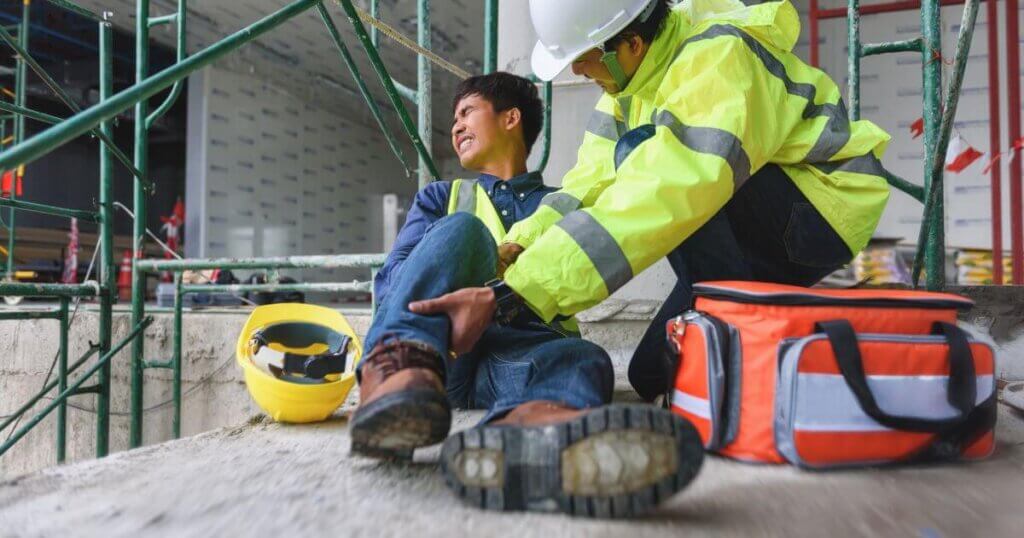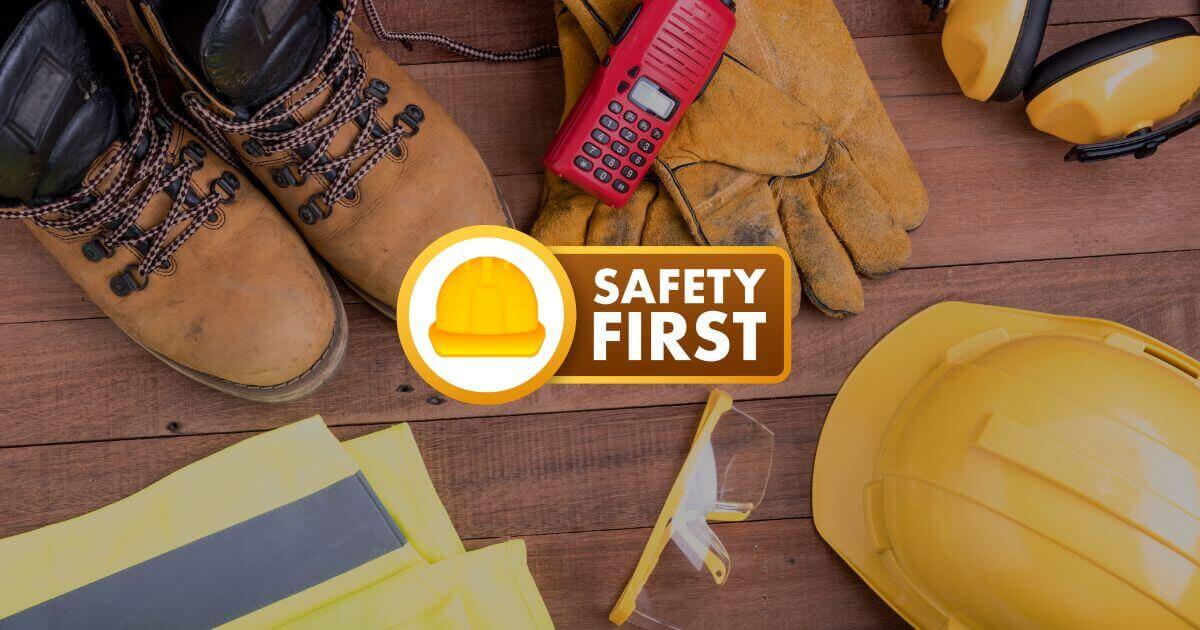Construction sites and other high-risk workplaces have serious safety challenges. Even a minor oversight can lead to costly accidents. When workers are injured, it affects their well-being, project timelines, and company resources. However, with the right strategies to prevent workplace injuries, many of these incidents are preventable.
Quick look
- Proper training, hazard recognition, and a strong safety culture can significantly reduce job site accidents.
- Falls, a lack of protective gear, and poorly maintained machinery are the leading causes of injuries, all of which can be mitigated with proactive measures.
- Tired workers are more prone to mistakes, and fostering a culture where safety is a shared responsibility helps prevent workplace injuries.
- Companies prioritizing safety see fewer injuries, reduced downtime, and lower liability costs, making it a win-win for workers and businesses.
The reality of workplace injuries

In high-risk industries like construction, workers face numerous daily hazards. The most common injuries include falls, being struck by objects, electrocutions, and incidents where individuals are caught in or between equipment. These types of accidents, often referred to as the “Fatal Four,” are responsible for a significant portion of construction-related fatalities. In 2021, nearly 1 in 5 workplace deaths occurred in the construction industry, with falls accounting for over a third of these fatalities.
The financial and human costs of these preventable workplace injuries are substantial. In 2022, work-related injuries in the United States cost $167.0 billion, including wage and productivity losses, medical expenses, and administrative costs.
Several factors contribute to the prevalence of these injuries:
- High-risk environments: Construction sites are dynamic and often involve working at heights, operating heavy machinery, and handling electrical systems, all of which increase the potential for accidents.
- Lack of training: Inadequate training can leave workers unprepared to recognize hazards or properly use safety equipment, leading to unsafe practices.
- Safety lapses: Failure to adhere to established safety protocols, whether due to oversight or intentional shortcuts, can result in hazardous situations.
- Failure to follow protocols: Neglecting standard operating procedures, such as securing ladders or wearing appropriate personal protective equipment (PPE), directly contributes to workplace incidents.
How to prevent workplace injuries
Safety should never be an afterthought on a job site. When workers are properly trained, follow protocols, and have access to the right equipment, the risk of injuries drops significantly. Accidents don’t just happen—they’re often the result of preventable hazards like poor training, lack of protective gear, or unsafe work conditions.
A proactive approach to safety can make all the difference. Companies that invest in strategies to prevent workplace injuries and enforce best practices protect their workers and reduce costly downtime, compensation claims, and liability risks. The Occupational Safety and Health Administration (OSHA) estimates that businesses spend $1 billion per week on direct costs related to workplace injuries. Preventing injuries isn’t just about compliance; it’s about creating a culture where safety is a shared responsibility.
Top tips to mitigate workplace injuries and keep workers safe
Preventing workplace injuries requires a proactive approach that uses several strategies to prevent workplace injuries beyond basic safety policies. Companies that invest in ongoing training, proper equipment, and a culture of safety see fewer accidents and better overall job site conditions. Here’s how to mitigate risks and keep workers safe:
Tip #1: Implement comprehensive safety training
One of the most effective ways to prevent workplace injuries is through consistent, hands-on safety training. Workers who understand potential hazards, know how to use protective equipment correctly, and are prepared for emergency situations are far less likely to be injured on the job.
- Regular training reduces human error: Many workplace accidents happen due to simple mistakes—misusing tools, ignoring safety procedures, or underestimating risks. OSHA reports that up to 90% of workplace injuries are caused by human error. Frequent training helps reinforce best practices and keep safety top of mind.
- Educate workers on PPE, hazard recognition, and emergency response: Workers should be trained on when and how to use personal protective equipment (PPE), such as helmets, gloves, and fall protection gear. They should also be able to identify common hazards—like unstable scaffolding, exposed wiring, or slippery surfaces—and respond appropriately in an emergency.
- Keep training updated to meet regulatory standards: Safety regulations change, and new equipment and techniques emerge. Employers should regularly update training programs to ensure compliance with OSHA, local regulations, and industry best practices.
Tip #2: Use proper personal protective equipment (PPE)
Personal protective equipment (PPE) is the last line of defense against workplace injuries, and using it correctly can mean the difference between a minor incident and a life-threatening accident. From hard hats to safety boots, every piece of PPE plays a crucial role in preventing injuries on the job site.
- PPE reduces the severity of injuries: Hard hats protect against falling objects, gloves prevent cuts and burns, and safety boots reduce the risk of crushing injuries.
- High-visibility clothing prevents accidents: On busy construction sites, being seen is just as crucial as being protected. Reflective vests and high-visibility clothing ensure that workers are easily spotted, especially in low-light or high-traffic areas, reducing the risk of struck-by accidents.
- PPE must be worn at all times: Safety gear is only effective if workers use it—and use it correctly. Employers should enforce PPE policies and conduct routine checks to ensure compliance. A study by the Bureau of Labor Statistics found that over 80% of head injuries occurred among workers who were not wearing hard hats at the time of the accident.
- Regular maintenance is key: Damaged or worn-out PPE can fail when workers need it most. To ensure their effectiveness, employers should implement regular inspections and replacements for items like helmets, gloves, and eye protection.
Tip #3: Prioritize fall protection
Falls are the leading cause of fatal injuries in the construction industry, accounting for more than one-third of all construction-related deaths each year. Whether working on scaffolding, ladders, or rooftops, fall protection is essential to keeping workers safe.
- Secure scaffolding and ladders: Faulty or improperly assembled scaffolding increases the risk of falls. To prevent accidents, employers must ensure that scaffolding is erected correctly, regularly inspected, and equipped with guardrails and toe boards.
- Use personal fall arrest systems (PFAS): Workers performing tasks at six feet or higher should wear a full-body harness attached to an anchor point that meets OSHA standards. Properly using a PFAS can significantly reduce the impact of a fall and prevent serious injuries.
- Ensure guardrails are in place: On elevated work surfaces, guardrails provide a crucial barrier that prevents workers from slipping or losing balance. OSHA requires guardrails on open sides of workspaces above six feet to protect against falls.
- Train workers on fall prevention: Know better, do better. Many falls occur due to a lack of proper training on using safety equipment or identifying risks. Regular training sessions on fall protection techniques can reduce accidents and ensure workers know how to protect themselves.
Tip #4: Keep worksites organized and hazard-free
A cluttered worksite isn’t just an eyesore—it’s a serious safety hazard. Slips, trips, and falls comprise over a third of common workplace injuries, many of which are caused by poor housekeeping. Keeping job sites clean, organized, and free of obstructions significantly reduces the risk of accidents.
- Regular inspections keep hazards in check: Supervisors and workers should conduct daily walk-throughs to identify and remove potential hazards. This includes securing loose cables, properly storing tools, and ensuring all walkways are clear.
- Proper storage prevents accidents: Keeping tools and equipment in designated areas reduces the risk of falls and injuries. Workers should be trained to return materials to their proper locations after use, and storage solutions should be easily accessible and clearly labeled.
- Eliminate slip hazards: Spills, wet surfaces, and uneven ground increase the risk of falls. To minimize these dangers, job sites should have non-slip mats, proper drainage, and immediate spill cleanup protocols.
- Mark and secure hazardous areas: Barriers or signage should mark open trenches, exposed rebar, and unfinished site sections. Unprotected openings should be covered, and warning signs should be posted in high-risk zones.
Tip #5: Promote a culture of safety awareness
A safe workplace isn’t just about following rules—it’s about creating a culture where everyone takes responsibility for safety. When workers feel empowered to speak up about hazards and look out for each other, job sites become safer and more productive.
- Encourage workers to report unsafe conditions: Many accidents could be prevented if workers felt comfortable reporting hazards. Many employees hesitate to speak up about safety concerns, fearing retaliation or being ignored. Employers should establish anonymous reporting systems and reassure workers that safety concerns will be taken seriously.
- Make safety a shared responsibility: Safety isn’t just the job of site supervisors—every worker plays a role in preventing accidents. Creating a culture where employees actively participate in safety efforts, from following protocols to watching out for co-workers, fosters a proactive mindset.
- Recognize and reward safe behavior: Positive reinforcement goes a long way. Companies implementing safety incentive programs—like recognizing workers who identify hazards or follow best practices—see higher engagement in workplace safety efforts. Companies with strong safety cultures typically experience 70% fewer incidents and have 52% lower injury costs.
- Conduct regular safety meetings: Toolbox talks and daily safety briefings help reinforce best practices, address new risks, and keep safety top of mind. These meetings should be interactive, allowing workers to share concerns and ask questions.
- Lead by example: Supervisors and managers set the tone for workplace safety. When leadership prioritizes and actively participates in safety protocols, workers are more likely to follow suit.
Tip #6: Conduct regular equipment maintenance
Faulty or poorly maintained equipment is a major contributor to workplace accidents, especially in the construction, manufacturing, and logistics industries. When machinery fails, it can lead to serious injuries, costly downtime, and even fatalities. Regular maintenance ensures that tools and equipment function properly, reducing the risk of malfunctions that could endanger workers.
- Routine inspections catch issues early: Establishing a preventive maintenance program helps identify problems before they lead to accidents. Regularly checking tools, machinery, and vehicles for wear and tear, leaks, loose parts, or electrical faults ensures they remain safe.
- Follow manufacturer guidelines for maintenance: Each piece of equipment comes with recommended inspection and servicing intervals. Adhering to these schedules keeps machinery in peak condition and prevents unexpected breakdowns.
- Encourage workers to report equipment issues: Employees who use machinery daily are often the first to notice strange noises, reduced efficiency, or mechanical issues. Encouraging workers to report problems immediately ensures that repairs happen before a malfunction leads to an accident.
- Use technology to track maintenance: Digital tracking systems or fleet management software help schedule and log maintenance, ensuring nothing gets overlooked.
Tip #7: Enforce strict vehicle and machinery safety rules
Heavy machinery and job site vehicles are essential to construction and industrial work, but they can become some of the most dangerous hazards when operated incorrectly. Accidents involving cranes, forklifts, bulldozers, and trucks often result in serious injuries or fatalities. Strict safety rules, proper training, and regular inspections significantly reduce these risks.
- Limit distractions while operating machinery: Just as distracted driving increases the risk of car accidents, distractions like texting, eating, or engaging in side conversations can have deadly consequences. Enforcing a zero-tolerance policy for distractions when using heavy equipment helps prevent costly mistakes.
- Conduct pre-shift inspections: Before using any machinery, operators should complete a pre-shift inspection to check for malfunctions, worn-out parts, or fluid leaks.
- Provide ongoing operator training. Even experienced workers benefit from refresher training on equipment handling, blind spot awareness, and emergency shutdown procedures. Continuous and consistent training can significantly reduce operator-related incidents.
- Implement traffic control measures: Job sites should have clear traffic flow plans to minimize interactions between workers and moving machinery. Flaggers, barricades, and designated pedestrian zones keep foot traffic safely separated from vehicle movement.
- Enforce seat belt and safety harness use: Many fatalities occur when operators fall from equipment or are ejected in a rollover accident. Properly using seat belts and safety harnesses inside enclosed cabs can prevent serious injuries.
Tip #8: Implement fatigue management strategies
Fatigue is one of the most overlooked safety hazards on a job site, yet it plays a significant role in preventing workplace injuries. When workers are exhausted, their reaction time slows, their focus diminishes, and the risk of making critical mistakes increases. Studies show that being awake for more than 17 hours impairs cognitive function as much as having a blood alcohol level of 0.05%, making fatigue just as dangerous as working under the influence.
- Ensure workers take adequate breaks: Pushing through exhaustion doesn’t lead to better productivity—it increases the risk of errors and injuries. Employers should enforce mandatory break times and encourage workers to avoid high-risk tasks if they feel too fatigued.
- Hydration and proper nutrition help maintain energy levels: Dehydration and poor nutrition worsen fatigue. Providing easy access to water stations and encouraging workers to eat balanced meals helps them stay alert throughout the day.
- Implement shift rotation to reduce overwork: Long shifts and excessive overtime lead to burnout, dramatically increasing the likelihood of accidents. Scheduling adequate rest periods between shifts and ensuring workers don’t operate heavy equipment when overly tired improves safety.
- Watch for signs of fatigue in workers: Supervisors should be trained to recognize signs of exhaustion, such as slow response times, difficulty concentrating, or unsteady movements. Workers should also be encouraged to speak up if they feel too fatigued to perform a task safely.
Bottom line
Workplace injuries affect entire projects, businesses, and bottom lines. When safety isn’t a priority, lost productivity, compensation claims, and costly downtime are just a few consequences companies face. More importantly, no job is worth a life or serious injury.
Companies can significantly reduce risk and keep workers safe by investing in proper training, enforcing the use of personal protective equipment (PPE), maintaining equipment, and promoting a culture of safety awareness. When safety becomes second nature, job sites become more efficient, morale improves, and costly accidents decrease.
Want to stay ahead of the latest safety trends, regulations, and industry best practices? Subscribe to our newsletter and follow us on social media for expert insights, safety updates, and tips to protect your team on the job!



